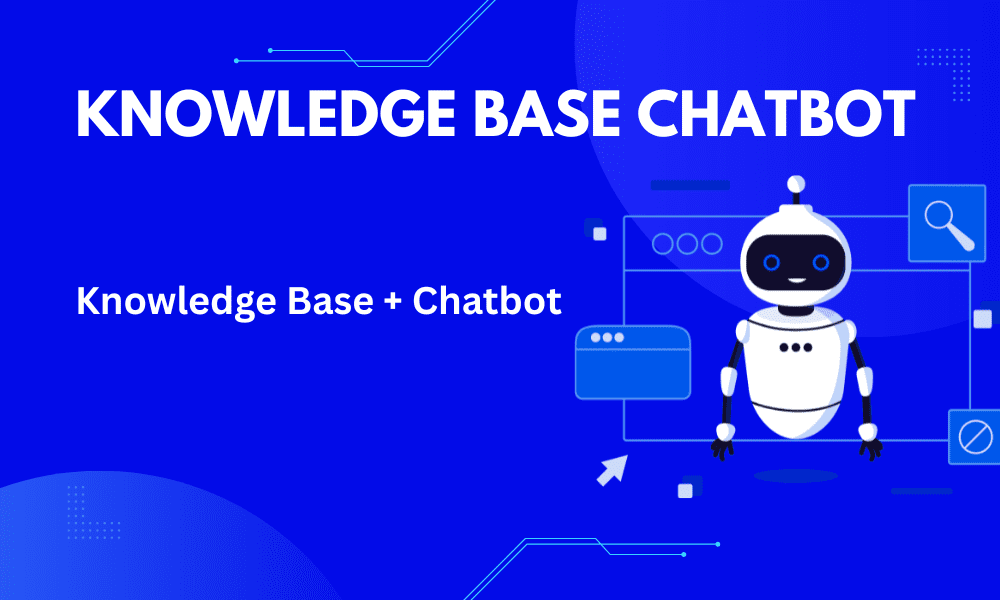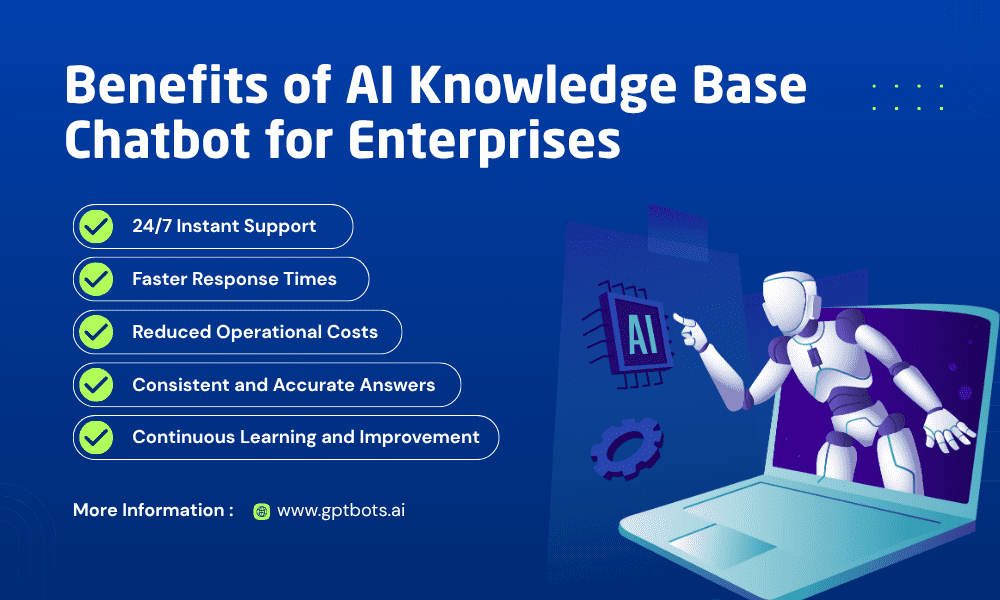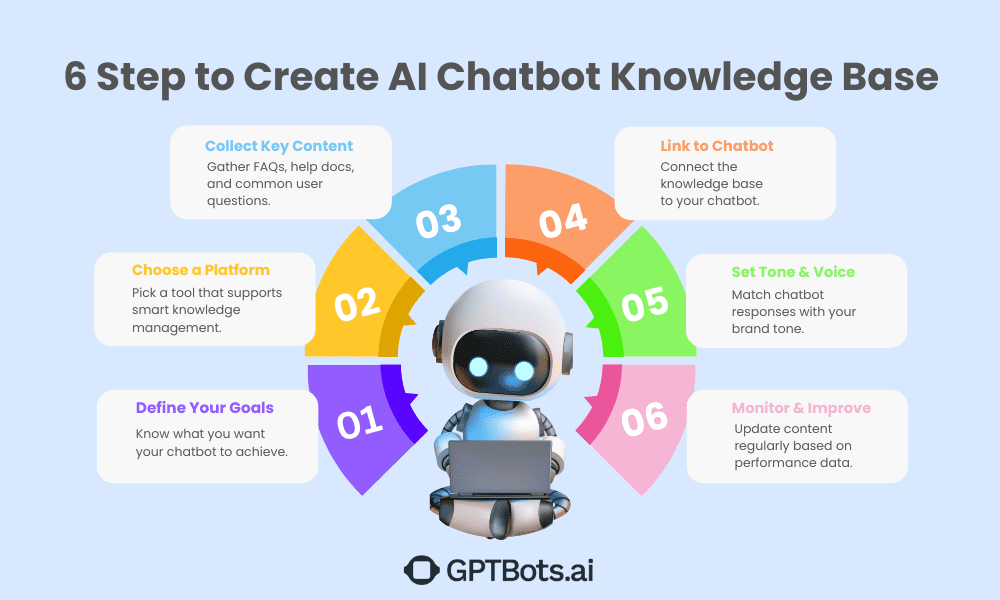In today’s competitive market, outstanding customer support is essential for retaining clients and winning new ones.
Coming out of the pandemic, customer expectations are rising as they're looking for quick responses and effective solutions to their queries at any time. This is where knowledge base chatbots come into play as the most effective self service solutions.
In this article, we'll introduce knowledge base and chatbots and how combining both technologies can revolutionize customer support and set your business apart. Let’s dive deeper into how knowledge base chatbots can transform your support strategy.
Part 1: What is a Knowledge Base Chatbot?

Businesses are increasingly relying on virtual agents to manage customer queries. These virtual agents can handle 80% of customer's routine queries with 90% success rate. That shows the effectiveness of Knowledge Base Chatbots for customer support.
To understand their value, it helps to first look at the two components that make them work: the knowledge base and the chatbot.
# Knowledge Base:
A knowledge base is a central repository of information that provides the customers a self-service option whenever they want troubleshooting or need more information. Knowledge base helps businesses to organize, store and manage the essential knowledge that they need to operate and respond.
You can consider knowledge base as a structured resource that includes articles, FAQs, guides and documents that help both the employees and the customers to solve a problem or answer common queries.
# Chatbot
Chatbot is an AI driven technology that interacts with humans through text or voice based interfaces. Chatbot is based on an input-output model where users or customers send a command, chatbot processes it and returns with an appropriate response.
Chatbots are of two types: rule based and AI.
Rule based chatbots respond to the query following a predefined script of rules created by humans. However, AI chatbots are more advanced and use Natural language Processing NLP to interpret the user's message and extract the context of the query to generate an appropriate and relevant response.
# Knowledge Base Chatbot
Knowledge based chatbot is an AI driven chatbot that connects the user to the company's knowledge base to provide one on one self service. These chatbots receive a user's question, interpret it to understand the context and then provide the most relevant and accurate information from their knowledge base.
Part 2: Importance of AI Knowledge Base Chatbot for Enterprises

Nowadays, a lot of customers prefer self service options over human customer support due to their many benefits. Around 70% of the customers now turn to self service for resolving issues or finding information.
These knowledge base chatbots not only provide quick answers to the users but also improve the efficiency and productivity of the team by managing repetitive tasks.
Below are some convincing reasons as to why enterprises should seriously consider Knowledge Base Chatbot for handling customer service queries;
- 24/7 Instant Support: Customers don't need to wait in long queues. AI driven knowledge base chatbot provides accurate answers anytime and anywhere,offering support beyond standard business hours.
- Faster Response Times: These chatbots offer faster response time as they can manage multiple queries at once. This reduces wait times and boosts customer satisfaction.
- Reduced Operational Costs: Enterprises can automate repetitive tasks with these AI driven chatbots. This reduces the need of customer support staff and resultantly lowers the operational cost.
- Eliminates Information Silos: In traditional setups, information and resources were often stored in separate systems or departments, making it hard for teams to find what they needed. AI-driven knowledge base chatbots break down these silos by instantly retrieving relevant data from across the organization’s centralized knowledge base. This ensures that teams in SaaS, healthcare, finance, and other industries can access consistent, up-to-date information without delays.
- Consistent and Accurate Answers: Human support can make mistakes and interpret policies differently. However, AI chatbots deliver standardized responses from a single knowledge base.
- Continuous Learning and Improvement: AI-driven chatot learns over time. As they interact with more users, they refine their ability to interpret the query correctly and provide more relevant answers, helping enterprises enhance customer experience while reducing the need for ongoing training.
Part 3: Which Business Can Benefit from AI Knowledge Base Chatbot?
Any business that serves a large audience and handles frequent customer queries can gain value from an AI knowledge base chatbot. These solutions are particularly impactful for industries where timely, accurate information is essential and customer expectations are high. Below are some examples of businesses that can benefit most from automating their customer support with AI-driven knowledge base chatbots:
1SaaS & Tech Companies
SaaS products have complex features that a wide audience can't understand easily, which leads to a high volume of support requests. AI Knowledge base chatbots can handle a huge number of such queries with instant answers related to product information, onboarding and troubleshooting.
2E-commerce & Retail
Ecommerce stores expreice huge customer support queries about order tracking, process returns and finding product information. AI chatbots provide instant information to such queries, improve customer satisfaction and reduce bounce rates.
3Healthcare Providers
This is another area where AI knowledge base chatbot is creating massive impact. Clients can easily get appointments, insurance details and answers to common medical FAQs. Information is accessible without any human delay.
4Financial Services & Insurance
Financial organizations can use AI chatbots to provide real-time policy information, handle transaction inquiries and claim procedures, as well as account management issues like checking balances, changing passwords, etc..
5IT Help Desks:
Technical issues can be challenging for non-experts, leading to many support tickets. AI chatbots resolve common technical issues and offer self service troubleshooting.
Part 4: 6 Steps to Create a Knowledge Base for a Chatbot

Building an effective knowledge base for a chatbot goes beyond simply storing information — it requires an intelligent platform that can understand, manage, and continuously improve the content to deliver precise and context-aware responses. A dynamic AI-driven knowledge base not only provides quick and accurate answers but also adapts to evolving customer needs, significantly boosting satisfaction and engagement.
So how to create such a smart knowledge base for your chatbot?
Platforms like GPTBots.ai combine advanced AI capabilities with streamlined tools to import, manage, and fine-tune knowledge. These AI platforms enable businesses to centralize their information while leveraging machine learning to optimize responses and improve over time. Selecting the right AI solution simplifies the process and ensures your chatbot performs at its best.
Here are six essential steps to create a powerful and AI-enhanced knowledge base for excellent performance of chatbot;
Step 1: Set Clear Goals for Your Knowledge Base Strategy
What do you want your AI chatbot to achieve? Do you want to deliver self-service support to customers, reduce wait times, or generate more leads? Or a combination of these goals?
When you know what exactly you want to achieve from this AI chatbot, you gather and organize information accordingly. This step will help you decide what type of information you need to provide and which chatbot solution is right for you.
Step 2: Pick the Right Platform
With goals in mind, now it’s time to select a knowledge base platform that offers advanced AI capabilities. A good platform ensure the chatbot accurately understands and extracts the right information to respond effectively to customer queries.
Step 3: Gather and Structure Key Content
Collect all relevant materials to train your chatbot so that it can answer different queries, address problems or troubleshooting. This can include resources like blog posts, FAQs and documents that are helpful for your users.
If you don't have any information or documents then think about the most common questions your customers ask, what problems they face most often. This will help you identify content gaps create targeted materials.
Step 4: Connect the Knowledge Base with the Chatbot
After assembling your content, connect the knowledge base to your AI chatbot. Some AI-driven platforms provide step-by-step guidance to enable your chatbot to leverage AI for understanding queries and delivering accurate, context-aware answers..
Step 5: Match Tone and Voice for Better User Interaction
After connecting the chatbot, run a test to make sure its responses reflect your brand’s tone and style, then iteratively refine content based on testing feedback. If some answers fall short, update the knowledge base with clearer or more relevant content.
Step 6: Keep Improving Through Regular Testing
As the enterprises expand, new challenges and customer questions will arise. Check the knowledge base analytics from time to time. Find all the failed searches. This will help you understand and find the knowledge gap. Create new content for those searches.
Part 5: How to Build and Train an AI Chatbot with Custom Knowledge Base?

Now it’s time to build a custom knowledge base chatbot. Once the knowledge base is ready and properly structured, the next step is to connect it with the AI chatbot.
So, how do you train a chatbot so it can:
- Understand how users ask questions?
- Recognize the different intentions behind each query?
- Respond with accurate and helpful answers?
- Suggest relevant alternatives when it can’t find an exact match?
Below are the key steps to building and training an AI chatbot with a custom knowledge base so that it understands your business, interpret customer needs, and deliver useful responses in real time.
1Connect Your Chatbot to the Knowledge Base
Link your AI chatbot with the structured knowledge base that you've built. The chatbot uses this data to deliver relevant answers instantly.
For example: Connect your chatbot to onboarding guides, FAQs or policy docs in formats like markdown and PDF.
2Train the Bot Using Real-World Queries
Use real user inputs such as chat logs, emails and support tickets to help the bot to understand how people actually ask questions in real life.
With the help of Natural Language Processing algorithm, it’ll interpret and understand the context behind the query. Even if there are grammatical mistakes, the chatbot will still understand it.
For example: A user type “can’t log in,” and the bot directs them to the login troubleshooting.
3Add Variations for Each Question
People often ask the same question in many different ways. Train the chatbot with synonyms, common typos, and informal phrases so it can link them to the correct resource. Over time, AI can also learn these variations automatically from user interactions.
For example: “Update billing,” “change payment,” and “edit card info” all point to the same payment update instructions.
4Test for Response Accuracy and Relevance
Test the chatbot to see how accurate and relevant responses it provides. Ask most common as well as edge case queries. Check how well your AI chatbot understands content, fetch data and provide relevant answers.
This will reveal where your knowledge base might be missing content..
For example: Ask “reset password,” and see if bot respond with clear instructions or unrelated info.
5Set Up Fallback Actions
People always come with new problems and queries and no chatbot is perfect. Create fallback flows for the queries that chatbot can't answer. This might include suggesting related topics or routing to human support for more personalized assistance.
For example: When customer asks an unknown question, the bot replies, “I couldn’t find that, but here are similar topics you might find helpful.”
6Refine with Analytics and Feedback
AI chatbot needs continuous improvements with time. With the help of chatbot analytics, you can monitor all the failed searches, drop off points and user feedback. Update your training data and knowledge base regularly for more accurate and relevant responses.
For example: You find that “delivery delay” appears often in failed queries, create a new article explaining delay causes and timelines.
Part 6: Build Powerful AI Knowledge Base Chatbot with GPTBots

In building an enterprise-grade knowledge base chatbot, the depth of technical capability and the flexibility of the platform determine whether it can truly deliver lasting value. GPTBots is not just an AI agent builder, but an end-to-end AI solutions provider that helps enterprises deploy intelligent agents across customer service, sales, enterprise search, and data analysis. It makes knowledge-based chatbots more accurate and human-like, while extending AI capabilities into more business processes to drive sustained growth.
# Key Advantages:
- Smarter AI Support - Automate up to 90% of customer inquiries in 90+ languages, cut costs, and provide human-like, knowledge-based answers 24/7.
- Unified Knowledge Access - Integrate documents, APIs, and databases for real-time, precise responses with intelligent follow-up suggestions.
- Low-Code Agent Building - Create and train AI chatbots in minutes, customize workflows, and connect to models like ChatGPT or DeepSeek.
- Scalable AI Intelligence - Deploy multi-agent setups that plan, execute, and handle complex, cross-functional tasks.
More Than a Knowledge Base—An AI Business Hub
With GPTBots, a knowledge base chatbot becomes more than a Q&A tool—it transforms into an intelligent business agent that retrieves, analyzes, and acts on information. This shift takes enterprises from simply answering questions to solving problems—faster, smarter, and at scale.







